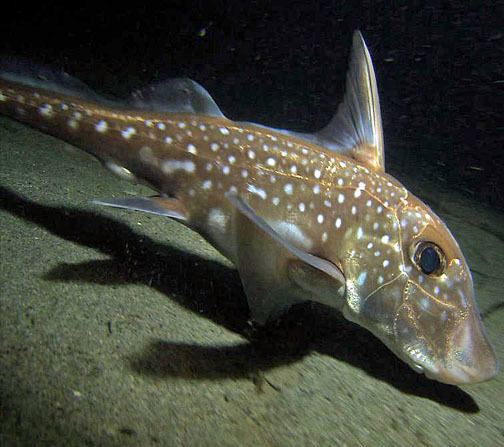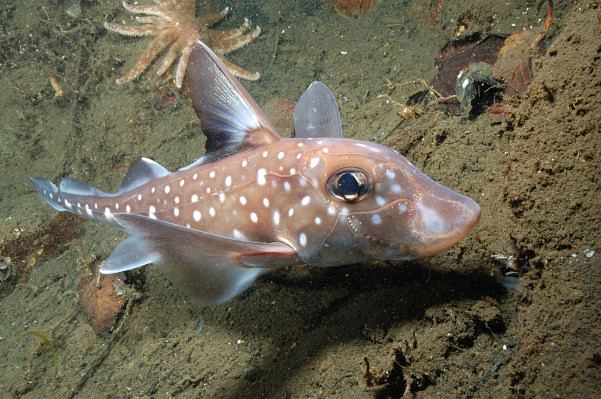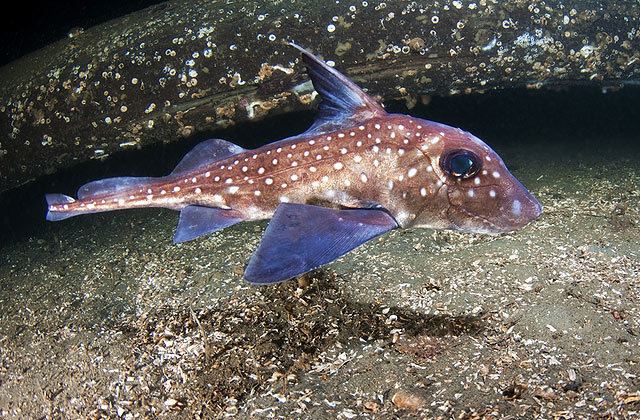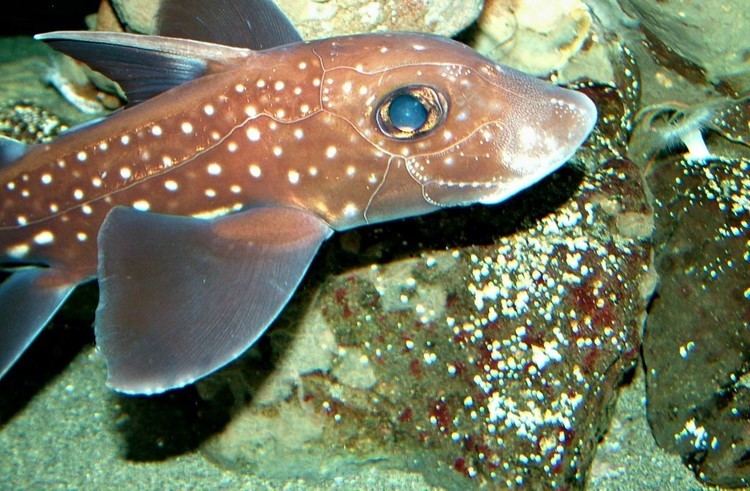Order Chimaera Phylum Chordata | Rank Species Higher classification Hydrolagus | |
 | ||
Similar Hydrolagus, Chimaera, Chimaeridae, Holocephali, Rabbit fish | ||
Spotted ratfish hydrolagus colliei
The spotted ratfish (Hydrolagus colliei) is a chimaera found in the north-eastern Pacific Ocean. Often seen by divers at night in the Pacific Northwest, this cartilaginous fish gets its characteristic name from a pointed rat-like tail. The ratfish lays leathery egg cases on the bottom of muddy or sandy areas which are often mistaken by divers as something inanimate. While mainly a deep-water species, it occurs at shallower depths in the northern part of its range. The generic name, Hydrolagus, comes from the Greek words ὕδωρ, meaning water, and λαγώς/λαγῶς, meaning hare, and the specific name honors Alexander Collie, who was a ship surgeon and early naturalist. The spotted ratfish is common in much of its range, not typically eaten by humans (the flesh is bland with an unpleasant aftertaste) and is not commercially caught.
Contents
- Spotted ratfish hydrolagus colliei
- Description
- Distribution and habitat
- Diet
- Reproduction
- Behaviour
- Albino Puget Sound ratfish
- References

Description

The spotted ratfish has a very distinct appearance compared to unrelated fish species. The female is up to 38 inches (97 cm) long, much bigger than the male. These fish have a smooth and scaless skin that is a silvery-bronze color, often with sparkling shades of gold, blue, and green. The speckled white spots along their back contribute to their name. Dark edges outline both the caudal and dorsal fins, whereas, the pectoral fins have a transparent outline. The ratfish’s pectoral fins are large and triangular, and extend straight out from the sides of their bodies like airplane wings. They have a venomous spine located at the leading edge of their dorsal fin, which is used in defense. It does not present a serious danger to humans, but can cause painful wounds and has been known to kill harbor seals that ate spotted ratfish (caused by the spine penetrating vital tissue in the stomach or esophagus after the ratfish was swallowed). The tail of the ratfish constitutes almost half of their overall length and closely resembles a pointed rat-like tail. The body of this fish is supported by cartilage rather than bone. It has a duckbill shaped snout and a rabbit-like face. The mouth is small and contains forward directed, incisor-shaped teeth, that act as plate-like grinding teeth. One of their most mesmerizing features is their large emerald green eyes which are able to reflect light, similar to eyes of a cat.
Distribution and habitat

The spotted ratfish can be found in the north-eastern Pacific Ocean, ranging from Alaska to Baja California with an isolated population in the Gulf of California. They are abundant in much of their range. They be found most commonly off the Pacific Northwest. The range of depths in which this fish is found extends from 0 to 913 m (0–2,995 ft) below sea level, but it is most common between 50 and 400 m (160–1,310 ft). Spotted ratfish typically live closer to the shore in the northern part of the range than in the southern, but it is also known as shallow as 30 m (98 ft) off California. Spotted ratfish tend to move closer to shallow water during the spring and autumn, then to deeper water in summer and winter. For most of the year they prefer temperatures between 7.2 and 8.9 °C (45–48 °F), but seasonally they do move into slightly warmer water. Spotted ratfish can most commonly be found living near the bottom of sand, mud or rocky reefs of the ocean floor. Unlike most of its relatives, which are entirely restricted to deep waters, the spotted ratfish has been held in public aquaria. It has also been bred in such aquaria, where two of the main issues are the requirement of low light and temperature (generally kept at 8–12 °C or 46–54 °F).
Diet

The spotted ratfish swims slowly above the seafloor in search of food. Location of food is done by smell. Their usual hunting period is at nighttime, when they move to shallow water to feed. Spotted ratfish are particularly drawn to crunchy foods like crabs and clams. Besides crabs and clams, the spotted ratfish also feeds on shrimp, worms, small fish, small crustaceans, and sea stars. Species known to prey on the spotted ratfish include soupfin sharks, dogfish sharks, Pacific halibut, pinnipeds and pigeon guillemots.
Reproduction
Like some sharks, spotted ratfish are oviparous. Their spawning season peaks during the spring to autumn months. During this time, the female releases up to two fertilized eggs into sand or mud areas of the seabed every 10 to 14 days. The extrusion process can last anywhere from 18 to 30 hours and the actual laying can last another four to six days. The egg sack is leather-like, five inches long, and has a filament connected to it which is used to attach it to the ocean floor when it is let go by the mother. It is not unheard of to see a female ratfish swimming around her newly laid eggs, in hopes of preventing predators from finding them. Development of the egg can take up to a year, which can be dangerous because the eggs are sometimes mistaken for inanimate objects by divers. When the young finally hatch, they are about 5.5 inches (14 cm) in length and grow, reaching 11.8 inches (30 cm) in length their first year.
Behaviour
The ratfish prefers to maintain a safe distance from divers, and are usually not aggressive. However, if they feel their territory has been invaded, the ratfish is able to inflict a mildly toxic wound with their dorsal fin spine. As they swim, the ratfish perform barrel rolls and corkscrew turns, as if they are flying.
Albino Puget Sound ratfish
A rare albino Puget Sound ratfish was discovered near Whidbey Island, Washington. It is the only pure albino among the 7.2 million specimens in the University of Washington's fish collection.
